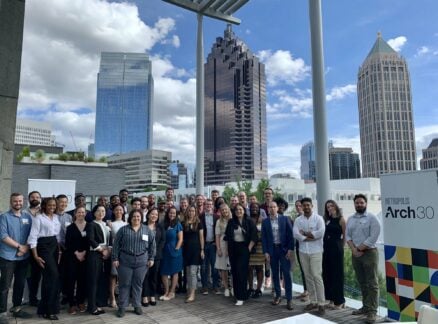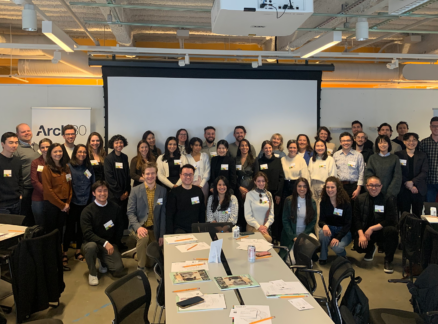August 1, 2005
A Green Blueprint
A Portland neighborhood may become a model for sustainable retrofits.
Lloyd Crossing, a 35-block section of Portland, Oregon, may be the first urban neighborhood in the country to get off the city grid and the planetary dole. Plans call for the office and retail district—dating from the heyday of freeway construction and passed over by the downtown boom of the last 20 years—to build up to eight million square feet of floor space, quadrupling its capacity to 21,000 residents and workers by 2050. Towers and mid-rise buildings will go up around the intersection of Portland’s MAX light rail and a scheduled streetcar extension. And during the same period net energy and water consumption will be reduced to levels nearly equivalent to a patch of native Northwest forest.
Sponsored by a city agency, the Portland Development Commission (PDC), and developed by a multidisciplinary team led by Mithun architects, Lloyd Crossing was recognized by the American Institute of Architects’ Committee on the Environment as one of this year’s “Top Green Projects” (in fact, they created a special planning category for the occasion). Executing the multilayer public-private partnership will provide experience that the city can transfer to other neighborhoods. More significantly Lloyd Crossing may serve as a blueprint remedy for all cities faced with rising air- and water-quality standards, rapid urban development, and the need for more power production and water-treatment plants. Though the plan includes a stand-alone demonstration project, most of the proposed changes reach for the future without breaking with the past. By adding local infrastructure to capture storm-water runoff and supply renewable energy, the neighborhood will reduce its dependency on the city’s sewage and power systems without getting rid of old pipes and lines. “If we can successfully implement [Lloyd Crossing],” PDC project manager Sloan Schang says, “then we have in effect created a new model for the development of urban areas.”
Here are seven steps that will drastically reduce Lloyd Crossing’s environmental footprint while quadrupling its density—and could be used to retrofit other urban neighborhoods:
1. Carve out bioswales to collect street runoff. The plan to radically “green” district streets calls for new open space, wildlife corridors, and the construction of bioswales at intersections. Each bioswale will replace one parking spot, and altogether they will collect 100 percent of storm runoff—water that would ordinarily go into the city’s central collection system. More than one-third of the rainwater will safely recharge local groundwater, just as it would have in an old-growth forest.
2. Treat wastewater in the neighborhood and reuse gray water. As part of the demonstration project, the district will get its own sewage-treatment facility. The technologies will be chosen during design, but plenty of examples exist, from bio-filtration systems to commercially available reverse-osmosis filtration systems. New buildings will have two water-supply lines—one for gray water (for toilets, irrigation, and in heating and cooling systems) and one for potable water (for drinking, bathing, and cooking).
3. Build according to stringent LEED silver standards. New construction will use high-performance low-maintenance materials with low embodied energy and high recycled content. To meet LEED silver certification, materials should come from within 500 miles of the project site and undergo life-cycle assessment.
4. Deploy photovoltaics to supplement power. Monocrystalline silicon photovoltaic (PV) modules will boost kilowattage. Although panels compete with environmentally beneficial green roofs atop real estate, there will be several arrays. PV technology will also appear in south-facing walls, cladding, and window shades. A future resource-management association can invest in three-quarter-miles of arrays on nearby I-84. All this will yield more than 10 megawatts of electricity, about 20 percent of the total needed.
5. Turn to wind turbines for energy. Although Portland lacks steady winds, Lloyd Crossing could derive energy savings of about one and a half megawatts per year—and lots of symbolic value—by installing wind turbines on poles. A horizontal-axis turbine with blade diameters up to 18 stories tall can effectively generate energy at low wind speeds. But the most important wind-power source may be outside the district in the wind-rich Columbia Gorge. Lloyd Crossing would meet remaining imported energy needs by buying wind-generated power, an option that now exists through PacifiCorp, the local electric utility, which is headquartered within the district.
6. Store and share heat in an underground thermal loop. Lloyd Crossing may be the first neighborhood to hook up to a thermal loop—an underground fluid-filled pipe, between two and four feet in diameter, that stores and redistributes heat. The Lloyd District Therm-al System of the future is a two-pipe system with a “hot” (60 degrees Fahrenheit) side and a “cold” (40 degrees Fahrenheit) side. It would recover heat lost in office-exhaust airstreams and deliver it to structures with a continuous need for heat, such as lodging and residential buildings. Pumps, valves, heat-exchange devices, and controls are installed in individual buildings, and the underground system is built on an as-needed basis.
7. Design new buildings to leverage natural forces. Configuring residential towers with 75 percent of windows on south and west elevations for optimal solar access will maximize the potential for daylighting, natural ventilation, and cooling. A computer model will further evaluate the effect of form, height, location, and orientation on solar access and natural ventilation in the neighborhood.





